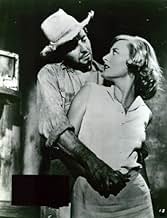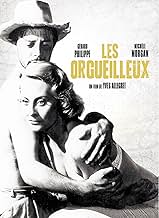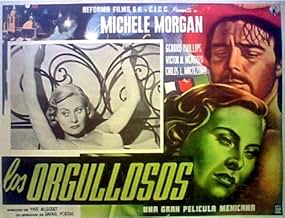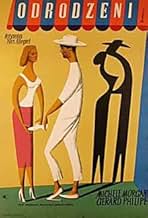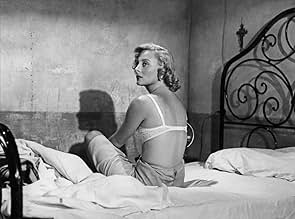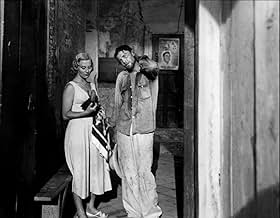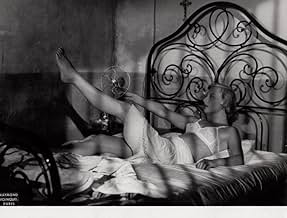अपनी भाषा में प्लॉट जोड़ेंLife in a small Mexican village where joy and misery, hope and pain, passion and guilt, love and decay, life and death are mixed in the peasants life and two French citizens who end up stran... सभी पढ़ेंLife in a small Mexican village where joy and misery, hope and pain, passion and guilt, love and decay, life and death are mixed in the peasants life and two French citizens who end up stranded in there, during a typhoid epidemic.Life in a small Mexican village where joy and misery, hope and pain, passion and guilt, love and decay, life and death are mixed in the peasants life and two French citizens who end up stranded in there, during a typhoid epidemic.
- 1 ऑस्कर के लिए नामांकित
- 1 जीत और कुल 3 नामांकन
Luis Buñuel
- Smuggler
- (बिना क्रेडिट के)
फ़ीचर्ड समीक्षाएं
This was Oscar-nominated in the "Best Writing, Motion Picture Story" category at the ceremony selecting the winning movies released in the U.S. during 1956; ironically, it was given in the name of celebrated author Jean-Paul Sartre – who, however, appears nowhere among the credits (but is then prominently displayed on native posters)
because the screenplay of the finished film was an adaptation of an unpublished one he had written back in 1944 (called "Typhus")! For the record, it was also awarded the Bronze Lion at the Venice Film Festival. A Franco- Mexican production set in the latter country, the dialogue alternates between French and Spanish throughout; indeed, translations in the former language are given for most of the Hispanic exchanges – however, these end up interfering with the newly-created English subtitles accompanying the movie for the entire duration! Incidentally, the IMDb lists Portas' alleged co-directing credit here
but, again, this is entirely omitted on the film proper!
Anyway, the torrid, crisis-torn setting (which invariably brings together a number of disparate characters) actually recalls a number of excellent contemporaneous French films – H.G. Clouzot's THE WAGES OF FEAR (1953) and two by my favourite auteur Luis Bunuel, DEATH IN THE GARDEN (1956) and REPUBLIC OF SIN (1959), with which this one even shares composer Paul Misraki and leading man Gerard Philipe respectively! In fact, here we deal with a village combating a meningitis epidemic: the local medic (played by Carlos Lopez Moctezuma – who apparently is no relation to Juan, cult director of "Nunsploitation" flick ALUCARDA {1975}) soon has his hands full with patients; Philipe, an ex-French doctor who took to the bottle after his wife died in his own care, helps out while being made a laughing stock of by the inhabitants. The first case is the spouse of elegant French lady Michele Morgan – in the second of five pictures she and Philipe appeared in, though two were compendiums and one a documentary in which the stars were featured as themselves! She takes an instant dislike to her grimy compatriot, yet becomes increasingly dependent on him when her own hubby perishes and the innkeeper forces himself upon her (typically more permissive than comparable Hollywood films of the era, Morgan is repeatedly seen in her underwear on account of the excessive heat) – she also incurs the jealousy of the latter's wife, another French expatriate. Finally, Philipe rekindles his vocation and decides to remain sober – while the heroine, who had intended leaving before a quarantine was ordered sealing off the village from the outside world, opts to stay behind due to her new-found feelings for the male protagonist
The handling is sturdy and the atmosphere vividly rendered, aided in no small measure by the cinematography of Alex Phillips (who had also lensed Bunuel's ASCENT TO HEAVEN and ROBINSON CRUSOE {both 1952}), the production design of Gunther Gerszo (who, apart from Bunuel's SUSANA {1951} and THE RIVER AND DEATH {1955}, would be responsible for several "Mexi-Horror" efforts) and a lively score – accentuated by loud yelps redolent of Latin American nonchalance! – from Misraki (later a collaborator of Orson Welles, not to mention exponents of the "Nouvelle Vague"). That said, there is an odd emphasis on showing its main characters humiliated (and at inordinate length, to boot!): now- penniless Morgan goes to wire her relatives in Paris for money, but she is forced to change pens numerous times because they run out of ink or break and then reduce her message because it exceeds the amount borrowed from the innkeeper!; Philipe, too, is literally made to dance for his share of rum (the drunkard act is slightly overstated, to be sure) – on the other hand, when he has to assist the doc in vaccinating Morgan and ordered to wash his hands, he complains that it will take another eight day's filth to bring them to their current state but, then, they are cleaned up in no time at all! Another minor quibble: with this type of film, there is usually some questioning of religious faith vis-a'-vis the significance of the plague – but, despite the obligatory presence of a curate, there is little of that feeling here!
I had missed out on a solitary screening of the movie under review (which, by the way, finds a place on the "Wonders In The Dark" website's ranking of the all-time top 3000 movies – while the Leonard Maltin guide, where it was listed under the alternate international title THE PROUD ONES, saw fit to raise its rating from *** to ***1/2) on a French Cable TV, where it was broadcast without the benefit of subtitles; normally, the channel concerned at least provided a French transcript of the dialogue – but this practice has long since been dropped! As for director Allegret, it is the fourth (and perhaps best) effort of his that I have watched after DEDEE' D'ANVERS (1948), MANEGES (1950) and LEATHERNOSE (1952); I also own one of his most highly-regarded works, SUCH A PRETTY LITTLE BEACH (1949; also with Philipe) while I did not take advantage of a late-night scheduling of MIRACLES ONLY HAPPEN ONCE (1951) – and as for the French-Italian anthology THE SEVEN DEADLY SINS (1952; one of the Philipe/Morgan collaborations I alluded to earlier on), it is only readily available via a trimmed Italian print!
Anyway, the torrid, crisis-torn setting (which invariably brings together a number of disparate characters) actually recalls a number of excellent contemporaneous French films – H.G. Clouzot's THE WAGES OF FEAR (1953) and two by my favourite auteur Luis Bunuel, DEATH IN THE GARDEN (1956) and REPUBLIC OF SIN (1959), with which this one even shares composer Paul Misraki and leading man Gerard Philipe respectively! In fact, here we deal with a village combating a meningitis epidemic: the local medic (played by Carlos Lopez Moctezuma – who apparently is no relation to Juan, cult director of "Nunsploitation" flick ALUCARDA {1975}) soon has his hands full with patients; Philipe, an ex-French doctor who took to the bottle after his wife died in his own care, helps out while being made a laughing stock of by the inhabitants. The first case is the spouse of elegant French lady Michele Morgan – in the second of five pictures she and Philipe appeared in, though two were compendiums and one a documentary in which the stars were featured as themselves! She takes an instant dislike to her grimy compatriot, yet becomes increasingly dependent on him when her own hubby perishes and the innkeeper forces himself upon her (typically more permissive than comparable Hollywood films of the era, Morgan is repeatedly seen in her underwear on account of the excessive heat) – she also incurs the jealousy of the latter's wife, another French expatriate. Finally, Philipe rekindles his vocation and decides to remain sober – while the heroine, who had intended leaving before a quarantine was ordered sealing off the village from the outside world, opts to stay behind due to her new-found feelings for the male protagonist
The handling is sturdy and the atmosphere vividly rendered, aided in no small measure by the cinematography of Alex Phillips (who had also lensed Bunuel's ASCENT TO HEAVEN and ROBINSON CRUSOE {both 1952}), the production design of Gunther Gerszo (who, apart from Bunuel's SUSANA {1951} and THE RIVER AND DEATH {1955}, would be responsible for several "Mexi-Horror" efforts) and a lively score – accentuated by loud yelps redolent of Latin American nonchalance! – from Misraki (later a collaborator of Orson Welles, not to mention exponents of the "Nouvelle Vague"). That said, there is an odd emphasis on showing its main characters humiliated (and at inordinate length, to boot!): now- penniless Morgan goes to wire her relatives in Paris for money, but she is forced to change pens numerous times because they run out of ink or break and then reduce her message because it exceeds the amount borrowed from the innkeeper!; Philipe, too, is literally made to dance for his share of rum (the drunkard act is slightly overstated, to be sure) – on the other hand, when he has to assist the doc in vaccinating Morgan and ordered to wash his hands, he complains that it will take another eight day's filth to bring them to their current state but, then, they are cleaned up in no time at all! Another minor quibble: with this type of film, there is usually some questioning of religious faith vis-a'-vis the significance of the plague – but, despite the obligatory presence of a curate, there is little of that feeling here!
I had missed out on a solitary screening of the movie under review (which, by the way, finds a place on the "Wonders In The Dark" website's ranking of the all-time top 3000 movies – while the Leonard Maltin guide, where it was listed under the alternate international title THE PROUD ONES, saw fit to raise its rating from *** to ***1/2) on a French Cable TV, where it was broadcast without the benefit of subtitles; normally, the channel concerned at least provided a French transcript of the dialogue – but this practice has long since been dropped! As for director Allegret, it is the fourth (and perhaps best) effort of his that I have watched after DEDEE' D'ANVERS (1948), MANEGES (1950) and LEATHERNOSE (1952); I also own one of his most highly-regarded works, SUCH A PRETTY LITTLE BEACH (1949; also with Philipe) while I did not take advantage of a late-night scheduling of MIRACLES ONLY HAPPEN ONCE (1951) – and as for the French-Italian anthology THE SEVEN DEADLY SINS (1952; one of the Philipe/Morgan collaborations I alluded to earlier on), it is only readily available via a trimmed Italian print!
`Les Orgueilleux' is one of a constellation of worthy French movies of this era that the French stopped making for two reasons: the complete lobotomy of the intellect that was the so-called New Wave and the premature death of Gérard Philipe, one of the century's finest actors. His pairing with Michèle Morgan here is inspired. (They also starred in René Clair's `Les Grandes Manoeuvres'.) In order to describe Philipe's charm, one has to evoke equal parts Leonardo DiCaprio and Laurence Olivier and imagine them cast as romantic leads in the kind of challenging narrative that is not even conceivable today, except for the odd exception. `Les Orgueilleux' is set during a typhus epidemic in a remote Mexican village and is based on Jean-Paul Sartre's novel `L'Amour rédempteur' (`Redeemed by Love', aka `Typhus'). The oversimplification of the novel's themes is compensated by Allégret's penchant for realism and his attention to details, like the long scene of Morgan enduring the discomfort and perils of a lonely hotel room during a heat wave in a third rate Mexican hotel, which is part striptease (daring for the time) and part psychological analysis. In other words, a perfect blend of commercialism and intelligence, both qualities sadly lacking from the aforementioned so-called New Wave.
One of the greatest films I've ever seen, this movie took me completely by surprise, considering I'd never heard of it, and the videotape cover was very cheesy. Set in a small Mexican town, the main character is a drunk who is so intoxicated throughout the movie he can hardly walk. A plague of cerebral-spinal meningitis hits the town. This film has a startlingly raw edge to it, like nothing else I've seen from the 50s, but more like a Midnight Cowboy kind of down-and-out unflinching view of human situations. One of the first images is of the drunk carrying a pig's head through the streets of town. He delivers it to a whorehouse. The prostitute offers to pay him with sex, but he chooses to be paid in tequila. There's another scene of him cleaning up vomit, and a scene where the local doctor, the drunk, and a woman tourist take turns inoculating each other in the spine with a huge needle. This is not to say that the film is shocking or gross, but simply human and realistic. The photography is utterly pure and perfect. Nearly every composition is dynamic, with a strong perspective, background and foreground in play, half the shots have some kind of movement, dolly or pan, which is used concisely and never intrusively. Every set up is intelligent, resourceful and well executed. The acting is simply brilliant, the stars are believable, realistic and likeable. I don't know the story behind this production, or why it has slipped into obscurity, but it struck me as one of the GREAT films, comparable to something by Robert Bresson(who is one of my favorite directors) so, as you can guess, I highly recommend this. It's a ten.
Allegret reached his peak in 1947-1949 with "Dédée d' Anvers" "une si jolie petite plage" and "manèges".Afterwards,his works became either disastrous ("la jeune folle" ) or academic (Zola's "Germinal")."Les orgueilleux" is a notable exception.Gerard Philippe's over the top portrayal of an always drunk deposed doctor is impressive.Michèle Morgan has never been so sensual.But what matters is the sultry moist atmosphere.Michèle Morgan is sweating throughout the whole movie.Very few things happen after Morgan's husband's death,but the depiction of a Mexican one-horse town during the Holy week is awesome.One could draw a parallel(almost bunuelian) between the Passion and Morgan's sentimental life:death on Good Friday of what she thought was the love of her life;resurrection on Easter day on the beach when she realizes she's found true love.
Yves Allégret was extraordinary when it came to making you FEEL what his characters endure:so strong the pictures are that we're hot,we sweat as much as them.He did the same in "une jolie petite plage" where the rain never stopped falling.Maybe he learned his lesson from Victor Sjostrom(Seastrom) who could make us feel" the wind" ,and in a silent movie at that.
Yves Allégret was extraordinary when it came to making you FEEL what his characters endure:so strong the pictures are that we're hot,we sweat as much as them.He did the same in "une jolie petite plage" where the rain never stopped falling.Maybe he learned his lesson from Victor Sjostrom(Seastrom) who could make us feel" the wind" ,and in a silent movie at that.
I saw this movie when it first came out, have not seen it since, but have remembered it vividly all these years. Seldom, if ever, has a film held me riveted the way this one did. Of course, I would have paid to see Michele Morgan read the Manhattan phone book, especially attired in a slip (no, I am not a lezzie). The mood created by the meningitis epidemic in Mexico and the sexual tension, created mostly by Morgan, are more enveloping than real life. This remains one of my top 10 - perhaps top 5 - favorite movies of all time. For the life of me, I cannot understand why there is neither a VHS nor a DVD version available, apparently anywhere. What can be done to rectify this situation? For years, I moaned about the lack of a DVD of The Informer. Now, one is available but only as part of the overpriced John Ford collection of some of his lesser films.
Jen
Jen
क्या आपको पता है
- ट्रिवियाJean-Paul Sartre wrote ten drafts for screenplays to be used by Columbia Pictures, of which only three were typed down. The other seven were sort of rejected, and one of these, 'Typhus' came to be the obvious inspiration for Les orgueilleux/Los Orgullosos, Yves Allégret's co-production with Mexico. The film won the Bronze Lion in the 1953 Venice Film Festival, ex-aequo with La guerra de Dios (1953), Pickup on South Street (1953), and Sinhá Moça (1953), and also a Special Prize from the same Jury. When the film was nominated for Best Writing, Motion Picure Story, for the 1957 Academy Awards - in the wake of the film's release in the USA, with promotional materials emphasizing it was "Jean-Paul Sartre's The Proud and the Beautiful", the French philosopher disowned his authorship. The film has also been said to be based on Sartre's novel, "L'amour redempteur"... which he never wrote! This myth did not end, even after its exposure as such in "Feature Cinema in the 20th Century: Volume One: 1913-1950: a Comprehensive Guide", by By Jacek Klinowski et al.
- कनेक्शनFeatured in Censura: Alguns Cortes (1999)
टॉप पसंद
रेटिंग देने के लिए साइन-इन करें और वैयक्तिकृत सुझावों के लिए वॉचलिस्ट करें
- How long is The Proud and the Beautiful?Alexa द्वारा संचालित
विवरण
- रिलीज़ की तारीख़
- कंट्री ऑफ़ ओरिजिन
- भाषाएं
- इस रूप में भी जाना जाता है
- The Proud and the Beautiful
- फ़िल्माने की जगहें
- उत्पादन कंपनियां
- IMDbPro पर और कंपनी क्रेडिट देखें
- चलने की अवधि1 घंटा 43 मिनट
- रंग
- ध्वनि मिश्रण
- पक्ष अनुपात
- 1.37 : 1
इस पेज में योगदान दें
किसी बदलाव का सुझाव दें या अनुपलब्ध कॉन्टेंट जोड़ें



